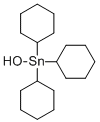Cyhexatin 三环锡
Introduction: Cyhexatin is a broad-spectum mites killer (baby mites,younger mites,grown up mites,summer eggs and especially effective to the mites that have adapted themselves to the organice phosphorus and organice chlorine pesticides ,Control of all motile stages of a wide range of phytophagous mites on fruit,such as apples, oranges, grapes, pears, maybushes, peaches, tea, trees, flowers, cotton, etc.
Common name: Cyhexatin
Another name: 'Aracnol F' (Diachem); 'Triran' (Chemia) Discontinued products: 'Plictran' * (DowElanco); etc.
Chemical name: tricyclohexyltin hydroxide
Empirical formula: C18H34OSn
Structural formula:

Mol. Weight: 385.17 g/mol
CAS No.: 13121-70-5
Specifications
Leading Cyhexatin supplier
Cyhexatin 95% TC
Cyhexatin 98% TC
Packing:
BULK PACKING
Powder: 25kg/Bag, 25kg/Drum, 50kg/Drum etc.
Liquid: 200L/Drum, 20L/Drum, 10L/Drum etc.
SMALL PACKING
Powder: 1kg/Alu bag, 500g/Alu bag, 200g/Alu bag, 100g/Alu bag, 50g/Alu bag, 15g/Alu bag etc.
Liquid: 5L/Drum, 1L/Bottle, 500ml/Bottle, 250ml/Bottle, 100ml/Bottle, 50ml/Bottle etc.
Customerized packing label
Cyhexatin FAO standard
Professional registration
HAZARDS IDENTIFICATION
Hazard statement(s)
H302: Harmful if swallowed.
H310: Fatal in contact with skin.
H315: Causes skin irritation.
H319: Causes serious eye irritation.
H335: May cause respiratory irritation.
H370: Causes damage to organs.
H372: Causes damage to organs through prolonged or repeated exposure.
H400: Very toxic to aquatic life.
H410: Very toxic to aquatic life with long lasting effects.
Precautionary statement(s)
P261: Avoid breathing dust/fume/gas/mist/vapors/spray.
P264: Wash ... thoroughly after handling.
P270: Do not eat, drink or smoke when using this product.
P271: Use only outdoors or in a well-ventilated area.
P273: Avoid release to the environment.
P280: Wear protective gloves/protective clothing/eye protection/face protection.
P301+P312: IF SWALLOWED: call a POISON CENTER/doctor/... IF you feel unwell.
P304+P340: IF INHALED: Remove victim to fresh air and keep at rest in a position comfortable for breathing.
P305+P351+P338: IF IN EYES: Rinse cautiously with water for several minutes. Remove contact lenses if present and easy to do - continue rinsing.
P310: Immediately call a POISON CENTER or doctor/physician.
P312: Call a POISON CENTER or doctor/... if you feel unwell.
P321: Specific treatment (see ... on this label).
P330: Rinse mouth.
P391: Collect spillage.
P403 +P233: Store in a well-ventilated place. Keep container tightly closed.
P405: Store locked up.
P501: Dispose of contents/container to.
Supplemental Hazard Statements: none.
MAMMALIAN TOXICOLOGY
Acute toxicity: 1) Acute oral LD50 for males rats is 407 mg/kg, for females rats is 265 mg/kg. 2) Acute dermal LD50 for males rats is 7600 mg/kg, for females rats is 3600 mg/kg.. 3) Acute inhalation toxicity LC50 (4 h) for rats is 0.016 mg/l. 4) Skin irritation: Irritating to skin (rabbits). 5) Eye irritation: Highly irritating to eyes (rabbits). 6) Skin sensitization for guinea pig: Weakly sensitizing (maximization test).
NOEL: (2 y) for rats is 0.34 mg/kg/day, (2 y) for mice is 3 mg/kg/day, (2 y) for dogs is 3 mg/kg/day. Other Not genotoxic in vivo. Unlikely pose a carcinogenic. risk to humans.
ADI (JMPR) 0-0.003 mg/kg b.w.[2005]
Classification:
WHO Classification: II (Moderately hazardous)
EC Risk Classification: Xn - Harmful: R20/21/22; N - Dangerous for the environment: R50, R53
US EPA Classification (formulation): III (Caution - Slightly toxic)
ECOTOXICOLOGY
Effect on birds: Acute oral LD50 for Bobwhite quail is 520 mg/kg. Effect on fish: Acute LC50 (96 h) for Perciformes is 0.06 mg/l. Effects on aquatic invertebrates: Acute EC50 (48 h) for Daphnia magna is 0.0002 mg/l. Effects on algae: Acute 72 hour EC50 for Scenedesmus subspicutus is 0.000018 mg/l. Effects on bees: Contact acute (48 h) LD50 is 32 μg/bee.
ENVIRONMENTAL FATE
EHC 15 (WHO 1980). Soil/Environment Dicyclohexyl tin hydroxide, monocyclohexyl tin hydroxide, and inorganic tin compounds are formed as metabolites. Degradation is promoted by u.v. light.
Usage: Cyhexatin was introduced by Dow Chemical Co. (now Dow Agro Sciences). It is an acaricide used to control mites on a variety of crops. Can also be a pesticide transformation product.
Application: Biochemistry Inhibitor of oxidative phosphorylation; disruptor of ATP formation. Mode of action Non-systemic acaricide with contact action. Uses Control of the motile stages of a wide range of phytophagous mites (adults and larvae) on pome fruit, stone fruit, vines, hops, nuts, bush fruit, strawberries, vegetables, tomatoes, cucurbits and ornamentals. Phytotoxicity Non-phytotoxic to deciduous fruit, vines, vegetables, and outdoor ornamentals. Slight injury (usually in the form of localised spotting) may occur on citrus fruit (particularly developing fruits and immature foliage), and glasshouse ornamentals and vegetables (seedlings and immature foliage).
| 






